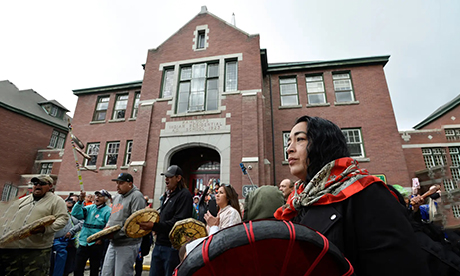Academics are calling into question the mass grave story surrounding the Kamloops residential school in Canada, according to the NY Times.
One year ago, the leaders of the British Columbia First Nation Band Tk’emlúps te Secwépemc announced the discovery of a mass grave of more than 200 indigenous children detected at a residential school in British Columbia.
“We had a knowing in our community that we were able to verify. To our knowledge, these missing children are undocumented deaths,” Rosanne Casimir, chief of the Tk’emlúps te Secwépemc, said in May 2021.
The Kamloops “discovery” of 2021 created a major sensation in Canada and abroad. The Canadian Press honoured the children of residential schools as the “Person of the Year 2021.”
In June, Pope Francis expressed his pain for “the shocking discovery in Canada of the remains of 215 children” at Kamloops. In an exceptional gesture, he promised to come to Canada.
However, according to several Canadian academics, what is still missing is proof human remains are in the ground.
The alleged burial ground was located with the help of ground-penetrating radar. It is said to include 215 bodies, some as young as 3 years old. The burial site is located on the grounds of the former Kamloops Indian Residential School which was run by the Roman Catholic Church from 1890 to 1978.
The number of bodies was based on irregularities in the ground ascertained by the radar waves, according to anthropologist Sarah Beaulieu, hired by the band to scan the site.
Her preliminary report is based on depressions and abnormalities in the soil of an apple orchard near the school – not on exhumed remains.
The “disruptions picked up in the radar,” she says, led her to conclude that the sites “have multiple signatures that present like burials”.
However, Beaulieu cannot confirm that until the site is excavated – if it is ever done.
Eldon Yellowhorn is a professor and founding chair of the Indigenous Studies department at Simon Fraser University in British Columbia. He has been searching for and identifying the gravesites of indigenous children at residential schools in Canada since 2009 after being hired by Canada’s powerful Truth and Reconciliation Commission (TRC).
Many of the graves he identified at residential schools in other parts of the country come from actual cemeteries. It is not always clear how the buried died.
Some of those found had succumbed to disease, Yellowhorn said. He cited one cemetery where it became apparent many children perished from the Spanish flu a century ago.
“I can understand why some people are sceptical about the Kamloops case,” Yellowhorn told The NY Post. “This is all very new. There’s a lot of misinformation floating out there. People are speaking from their emotions.”
As Yellowhorn sees it, the actual evidence for the mass grave at the Kamloops site is thin.
“All the radar shows you is that there are anomalies or reflections,” he said.
“The only way to be certain is to peel back the earth and ascertain what lies beneath. We have not gotten to the point where we can do that. It’s a huge job.”
Despite his own scepticism, Yellowhorn says it’s entirely possible that if excavations are ever carried out at Kamloops, actual human remains could be found.
Sources
